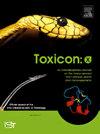Feasibility study: Varespladib protects CD-1 mice from lethal doses of whole bee (Apis mellifera) venom
IF 2.8
Q2 TOXICOLOGY
引用次数: 0
Abstract
Swarming Hymenoptera attacks can deliver high cumulative doses of venom resulting in death and life-threatening or chronically disabling injuries. Varespladib, a potent inhibitor of snake venom secretory PLA2 (sPLA2), is a relatively weak inhibitor of whole bee venom sPLA2 in vitro (pico-to low nanomolar for snake venom compared to M for Apis millera). Animal studies of varespladib against wasp (Vespa mandarinia) venom have shown promise against both nephropathy and coagulopathy, major markers of severe systemic toxicity distinct from hypersensitivity such as anaphylactoid and anaphylaxis reactions. We conducted a simple pilot study to evaluate if varespladib could feasibly decrease mortality against lethal doses of honeybee (Apis mellifera) venom in a murine model. When pre-mixed with a single dose of 10 mg/kg varespladib and administered intravenously (IV), varespladib prevented all mortality (0 of 10) in comparison to a cohort of mice administered lethal doses of whole bee venom alone (6 of 10) during a 24-h study period (N = 10 each group; log rank χ2 = 8.29; p < 0.005), and it eliminated signs of toxicity within 2 h while control animals either died or continued to show signs of toxicity. Survival in these animals despite poor in vitro sPLA2 inhibition suggests that suppression of the host sPLA2 response itself might play a role in the treatment of venom toxicity using an enzyme inhibitor rather than antivenom antibodies. Varespladib could be a useful tool for dissecting fundamental interactions between exogenous toxins and their corresponding endogenous counterparts.

可行性研究:Varespladib保护CD-1小鼠免受致死剂量的全蜜蜂(Apis mellifera)毒液
蜂群攻击膜翅目昆虫会释放大量累积毒液,导致死亡、危及生命或长期致残。Varespladib是一种有效的蛇毒分泌PLA2 (sPLA2)抑制剂,在体外是一种相对弱的全蜂毒sPLA2抑制剂(蛇毒为微摩尔到低纳摩尔,而蜜蜂为μ摩尔)。varespladib抗黄蜂(Vespa mandarinia)毒液的动物研究已经显示出对肾病和凝血功能障碍的治疗前景,这是严重全身毒性的主要标志,不同于过敏反应(如类过敏反应和过敏反应)。我们进行了一项简单的初步研究,以评估varespladib是否可以在小鼠模型中降低致命剂量蜜蜂(Apis mellifera)毒液的死亡率。当与单剂量10mg /kg varespladib预混合并静脉注射(IV)时,与单独给药致死剂量的全蜂毒(6 / 10)小鼠相比,varespladib在24小时的研究期间(每组N = 10)预防了所有死亡(0 / 10);Log rank χ2 = 8.29;p & lt;0.005),并且在2小时内消除了毒性迹象,而对照动物要么死亡,要么继续表现出毒性迹象。尽管体外sPLA2抑制较差,但这些动物的存活表明,抑制宿主sPLA2反应本身可能在使用酶抑制剂而不是抗蛇毒抗体治疗毒液毒性中发挥作用。Varespladib可能是解剖外源性毒素与其相应的内源性毒素之间基本相互作用的有用工具。
本文章由计算机程序翻译,如有差异,请以英文原文为准。
求助全文
约1分钟内获得全文
求助全文
来源期刊

Toxicon: X
Pharmacology, Toxicology and Pharmaceutics-Toxicology
CiteScore
6.50
自引率
0.00%
发文量
33
审稿时长
14 weeks
 求助内容:
求助内容: 应助结果提醒方式:
应助结果提醒方式:


